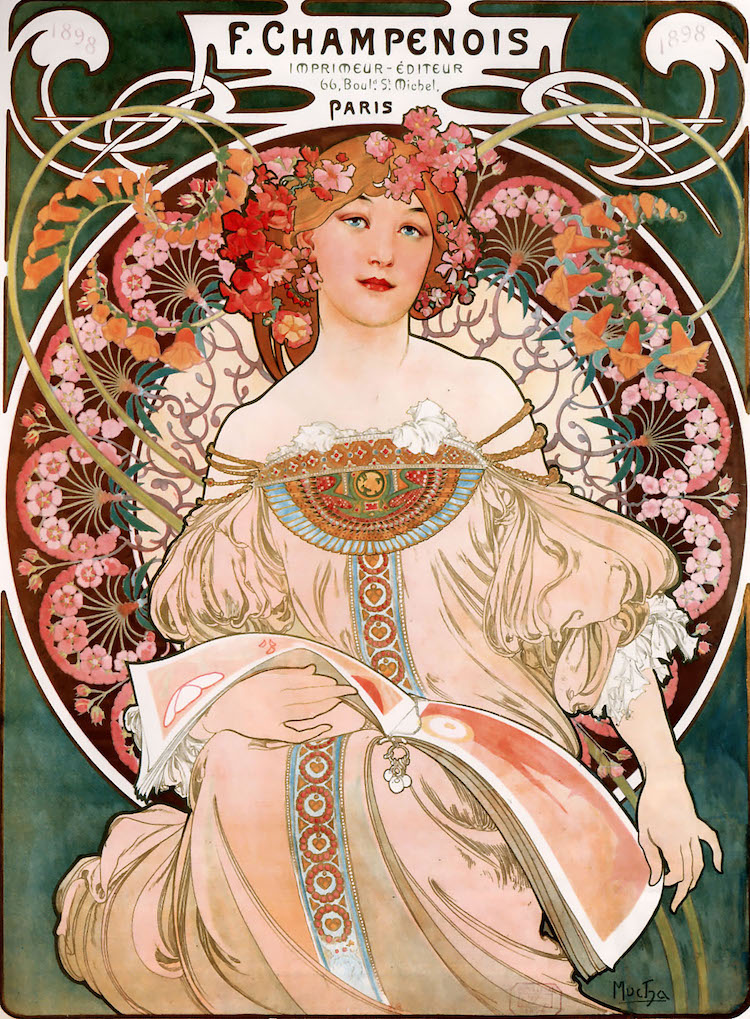Also dubbed as the ‘International Style,’ Art Nouveau was called different names in different places throughout the 19th century. It sought to let go of the past and create something modern. Whether it achieved that or not however is up to your interpretation, as we will see below.
The Origins of Art Nouveau
Art Nouveau was a form of art that took place in Europe and America from 1890 to 1910. It has appeared in illustrations, posters, interior design, furniture design, glass decoration, jewelry, architecture and several other fields. It grew out of a desire to move away from the older styles of art prevalent in the 1800’s. This style drew inspiration and evolved from a variety of other movements including the Arts and Crafts movement and the ukiyo-e prints from Japan (may have inspired Art Nouveau’s well-known ‘whiplash curves’). The style was created out of a need to bridge the space between the fine and applied arts. Many considered painting and sculpting as better than the decorative crafts. Art Nouveau wanted to change this. They believed that any everyday object can be made beautiful. In fact, Art Nouveau was a style intended to unite all forms of art.
Recipe for Fame: The Distinct Characteristics of Art Nouveau
Nature
Art Nouveau drew a great deal of inspiration from the natural world around us. The shapes were organic and used a lot of twirling lines, often referred to as ‘whiplash curves.’ For example, the glass decoration below uses a lot of flowers, shapes from nature and flowing lines.

Image Source: https://www.europeana.eu/en/exhibitions/art-nouveau-a-universal-style/inspired-by-nature
Women
Women were also a central theme seen on Art Nouveau posters. During this time, women started experiencing a lot more freedom and were portrayed in a more independent manner. Again they were surrounded by wavy lines and whiplash curves. Like in ukiyo-e prints, they were portrayed as beautiful figures.

Image Source: https://mymodernmet.com/alphonse-mucha-art-nouveau-posters/
Asymmetry
Unlike most poster designs that liked to use symmetrical balance, Art Nouveau posters made well use of asymmetrical balance. Asymmetry was used to give it a more natural feel.

Image Source: https://www.britannica.com/art/Art-Nouveau
20th Century and Beyond
It’s clear that the style of Art Nouveau had a huge impact during it’s time. However, it started to decline in the 20th century and was preceded by Art Deco. What I find most sad is that Art Nouveau didn’t quite achieve what it had aimed for. The artists thought that by embracing the machine production of goods, they could appeal to a wider audience. However, there was still a lot of hands on work involved to create the intricate patterns and therefore didn’t reach as much people as they had initially hoped for. Moreover once all the exhibitions and fairs that got the style famous in the first place closed down, it’s popularity started to decline. Despite all of this, there was one principle that emerged out of this period that continues to be relevant today. It is the principle that form should follow function. The designers of the period wanted to move away from the old styles with excessive decoration. They wanted something new and this concept would later go on to influence the Bauhaus Principles.
Sources:
https://www.britannica.com/art/Art-Nouveau
https://www.europeana.eu/en/exhibitions/art-nouveau-a-universal-style/inspired-by-nature
https://www.theartstory.org/movement/art-nouveau/
https://www.theartstory.org/movement/art-nouveau/history-and-concepts/
https://www.europeana.eu/en/exhibitions/art-nouveau-a-universal-style/origins-of-art-nouveau
https://mymodernmet.com/alphonse-mucha-art-nouveau-posters/
https://www.europeana.eu/en/exhibitions/art-nouveau-a-universal-style/women-in-art-nouveau
http://www.visual-arts-cork.com/history-of-art/art-nouveau.htm
https://www.britannica.com/art/Art-Nouveau
http://www.studiodk.com/blog//history-of-art-nouveau-architecture
Leave a Reply